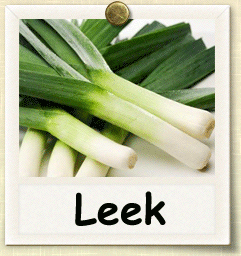|
Home > Guides > Vegetables > Leek |
|
How to Grow Leek | Guide to Growing Leek |
|
|
|
|
| |
 |
|
Overview |
|
|
|
|
|
| |
|
| |
Milder flavored than most other onion-family crops, you can mulch long-season varieties in fall for winter and spring harvest. |
|
| |
|
|
| |
|
|
| |
|
|
|
|
|
|
|
|
|
Well Drained, High Fertility |
|
|
|
|
|
|
|
|
|
|
|
|
Growing Guide
GROWING NOTES
Well-drained, rich soil, high in organic matter. Optimum pH is 6.2 to 6.8. Requires plentiful, even moisture for good yields.
Biennial grown as an annual.
Long-season varieties have a dark, bluish-green color.
MAINTAINING
Choose a weed-free, well-drained location. Raised beds are ideal. Leeks are good for intercropping with other garden plants, especially early-maturing spring greens. Do not plant where other onion family crops have been grown in the past 3 years.
You can direct-seed leeks, or start transplants indoors. Long-season varieties are best started indoors.
Start transplants about 8 to 10 weeks before last frost date. Sow seeds in flats about ¼ inch apart and ½ inch deep. Transplant to cell-type containers when they are about 2 inches tall. If you skip this step and continue growing in open flats, simply tease apart and trim roots when transplanting into the garden.
Around the average last day of frost, set hardened-off transplants 4 to 8 inches deep, 4 to 6 inches apart, in rows 20 inches apart. Deep planting reduces need for hilling to blanch the base of the plants. Transplants should be about 6 to 12 inches tall - the bigger, the better. Only a few inches of leaf need to show above the soil.
Direct seed about 4 weeks before average last frost ½ inch deep, 1 inch apart, in rows 20 inches apart. Thin to 4 to 6 inches apart.
Hill or mound soil around stems several times to blanch as leeks grow. (A single large hilling while plants are young can cause them to rot.) Or, place a portion of cardboard paper towel center around the lower part of the stem.
Leeks have shallow root systems and need consistent moisture and good weed control. Water weekly if weather is dry, and mulch to retain moisture and suppress weeds.
|
|
| |
|
| |
Heirloom seeds are the gardeners choice for seed-saving from year-to-year. Learning to save seeds is easy and fun with these books. Before you harvest, consider which varieties you might want to save seeds from so that your harvesting practice includes plants chosen for seed saving. Be sure to check out our newest seed packs, available now from Heirloom Organics. The Super Food Garden is the most nutrient dense garden you can build and everything you need is right here in one pack. The Genesis Garden s a very popular Bible Garden collection. The Three Sisters Garden was the first example of companion planting in Native American culture. See all of our brand-new seed pack offerings in our store.
|
|
| |
|
|
| |
Harvesting Guide
HARVESTING
Leeks are easy to harvest. They have a relatively long growing season, meaning you can harvest leeks all summer long in some areas. After the harvest begins, prolong it by only picking the leeks you plan to use, allowing the rest to continue growing.
When to Harvest - Leeks are typically harvested during late summer or early autumn. In practice, leek harvesting can begin about 60 days after planting and continue until the harvest is complete, or the weather makes further harvest unfeasible. Be aware of the weather and fully harvest all remaining leeks ahead of the first hard freeze.
How to Harvest - Vegetable garden leeks should be removed whole. If you grip the top of the plant and pull, it is likely to break, and much of the leeks will be lost. Instead, loosen the soil with your fingers and lift out the leeks by their root systems.
Prolong Harvest for Soil Protection - You can continue growing leeks until the first hard frost kills them back. By harvesting slowly, you allow the unharvested leeks to grow larger and more flavorful. Only pick what you need until the danger of a freeze prompts completing the full harvest.
SAVING SEEDS
Leeks survive the winter easily in most regions, especially with a little mulch. Eat the blanched stem in early spring for a tasty treat! In their second year, each leek has a wonderful spherical flower which could easily qualify as an ornamental specimen. The flower produces hundreds of seed pods.
|
|
| |
|
|
|
| |
|
|
|
|
|
| You can find this variety in the following Seed Packs: |
|
 |
|
| Click the packs below to see some of our other wonderful products |
|
|
|
|
|
|
|